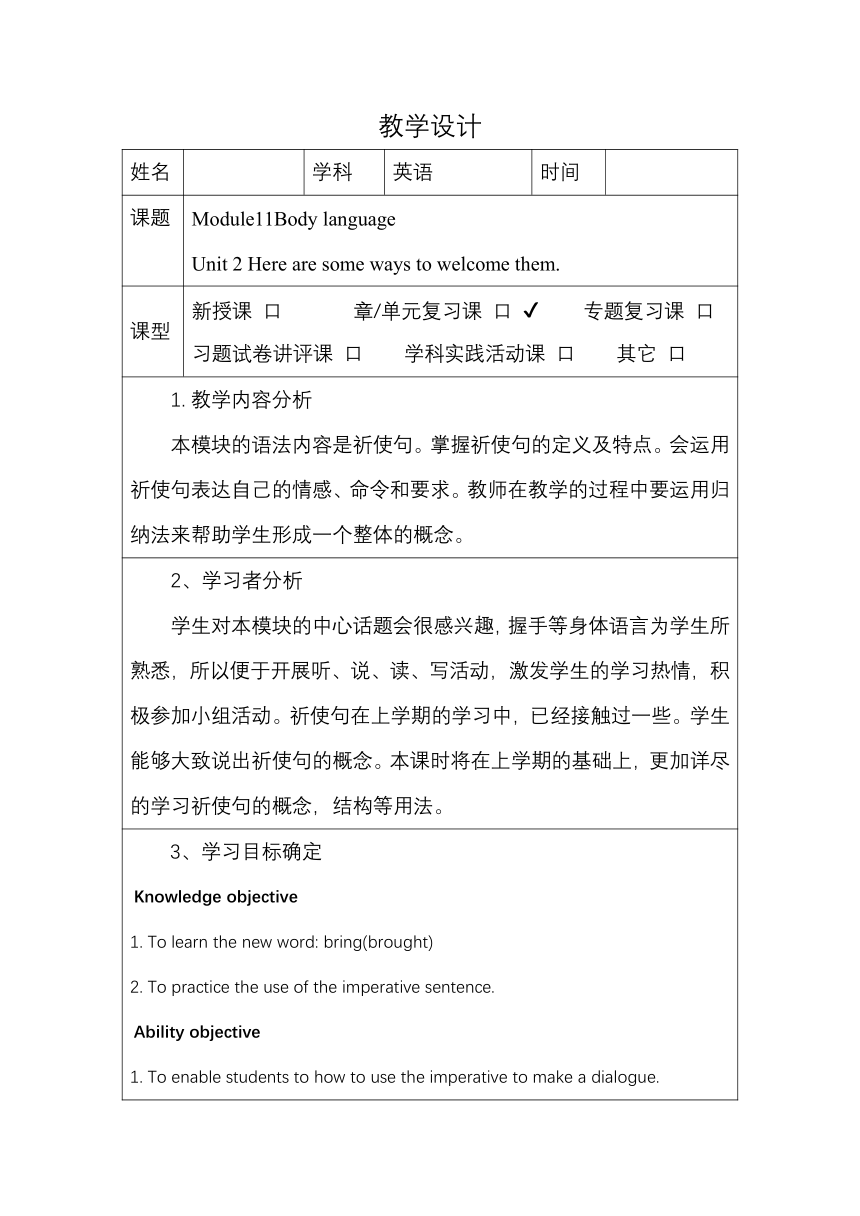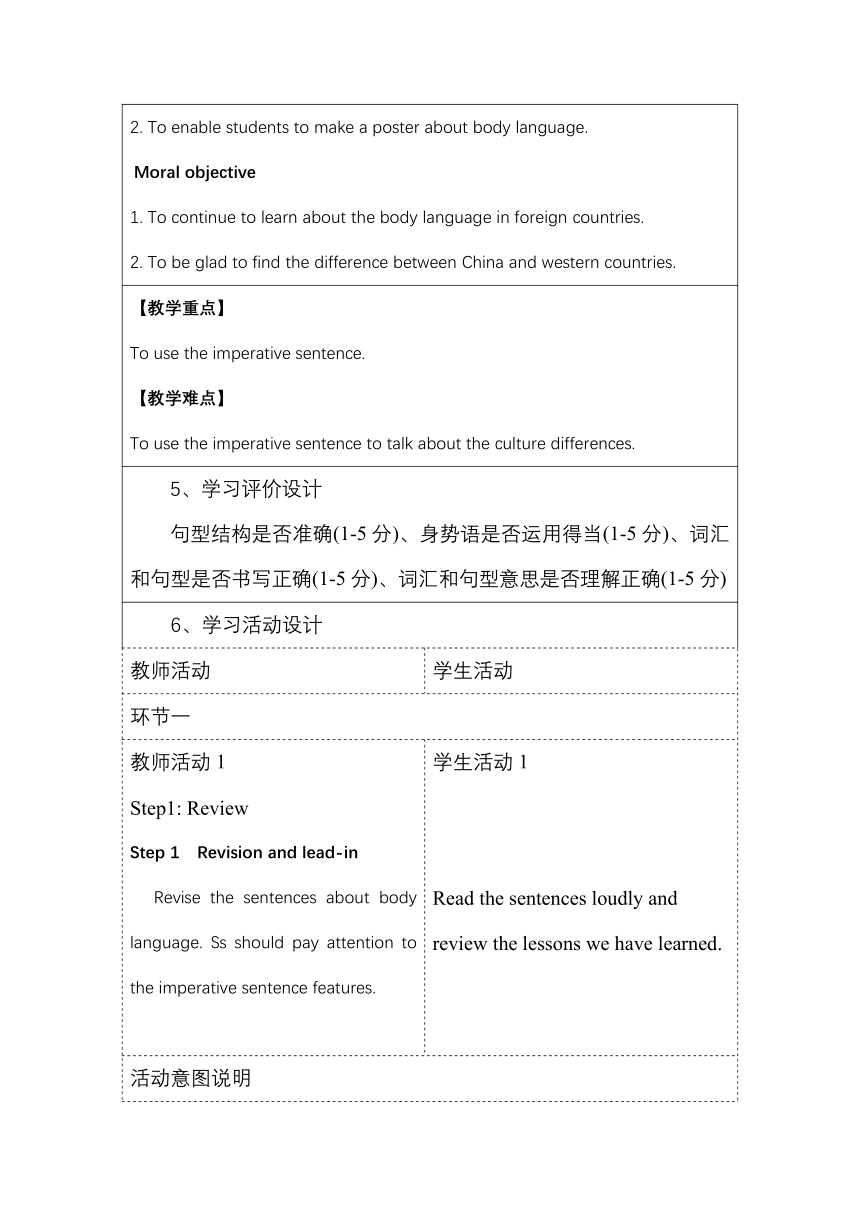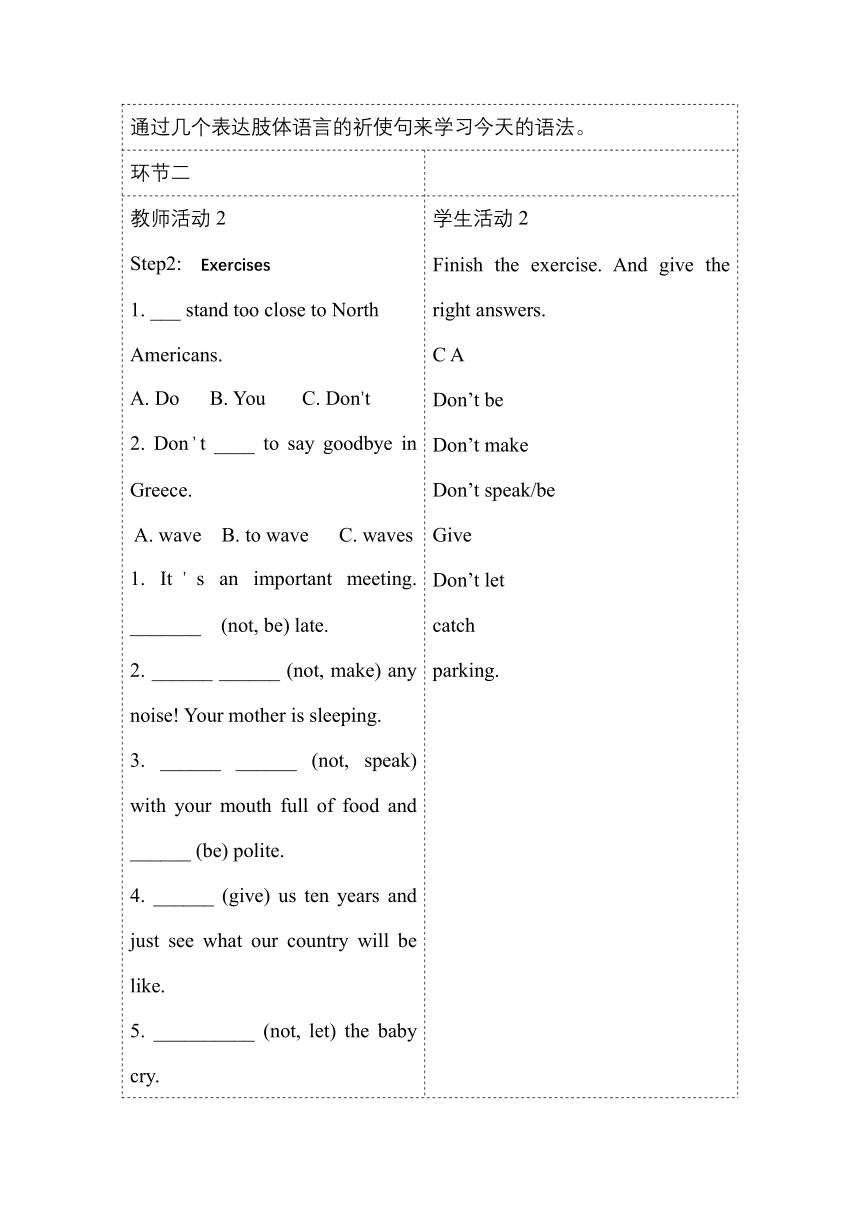外研(新标准)版 七年级下 Module 11 Body language Unit 2教学设计(表格式)
文档属性
| 名称 | 外研(新标准)版 七年级下 Module 11 Body language Unit 2教学设计(表格式) |  | |
| 格式 | docx | ||
| 文件大小 | 301.2KB | ||
| 资源类型 | 教案 | ||
| 版本资源 | 外研版 | ||
| 科目 | 英语 | ||
| 更新时间 | 2022-07-10 08:07:03 | ||
图片预览



文档简介
教学设计
姓名 学科 英语 时间
课题 Module11Body language Unit 2 Here are some ways to welcome them.
课型 新授课 口 章/单元复习课 口 专题复习课 口 习题试卷讲评课 口 学科实践活动课 口 其它 口
教学内容分析 本模块的语法内容是祈使句。掌握祈使句的定义及特点。会运用祈使句表达自己的情感、命令和要求。教师在教学的过程中要运用归纳法来帮助学生形成一个整体的概念。
2、学习者分析 学生对本模块的中心话题会很感兴趣,握手等身体语言为学生所熟悉,所以便于开展听、说、读、写活动,激发学生的学习热情,积极参加小组活动。祈使句在上学期的学习中,已经接触过一些。学生能够大致说出祈使句的概念。本课时将在上学期的基础上,更加详尽的学习祈使句的概念,结构等用法。
3、学习目标确定 Knowledge objective 1. To learn the new word: bring(brought) 2. To practice the use of the imperative sentence. Ability objective 1. To enable students to how to use the imperative to make a dialogue. 2. To enable students to make a poster about body language. Moral objective 1. To continue to learn about the body language in foreign countries. 2. To be glad to find the difference between China and western countries.
【教学重点】 To use the imperative sentence. 【教学难点】 To use the imperative sentence to talk about the culture differences.
5、学习评价设计 句型结构是否准确(1-5分)、身势语是否运用得当(1-5分)、词汇和句型是否书写正确(1-5分)、词汇和句型意思是否理解正确(1-5分)
6、学习活动设计
教师活动 学生活动
环节一
教师活动1 Step1: Review Step 1 Revision and lead-in Revise the sentences about body language. Ss should pay attention to the imperative sentence features. 学生活动1 Read the sentences loudly and review the lessons we have learned.
活动意图说明 通过几个表达肢体语言的祈使句来学习今天的语法。
环节二
教师活动2 Step2: Exercises 1. ___ stand too close to North Americans. A. Do B. You C. Don’t 2. Don’t ____ to say goodbye in Greece. A. wave B. to wave C. waves 1. It’s an important meeting. _______ (not, be) late. 2. ______ ______ (not, make) any noise! Your mother is sleeping. 3. ______ ______ (not, speak) with your mouth full of food and ______ (be) polite. 4. ______ (give) us ten years and just see what our country will be like. 5. __________ (not, let) the baby cry. 6. Wear more clothes or you _____ (catch) a cold. No _________. (park) Rewrite the sentences 1. It’s important to be careful. 2. It’s important to clean and tidy the lab. 3. You cannot touch anything if the teacher doesn’t ask you to. 4. You cannot bring food or drink into the lab. 5. You cannot enter the lab alone. 学生活动2 Finish the exercise. And give the right answers. C A Don’t be Don’t make Don’t speak/be Give Don’t let catch parking. Be careful. Clean and tidy the lab. Don’t touch anything if the teacher doesn’t ask you to. Don’t bring food or drink into the lab. Don’t enter the lab alone.
活动意图说明 布置任务,通过习题练习来检测、巩固本课时所学语法。
环节三
教师活动3 Step3: Work in pairs. 1.Talk about 2.Make a list of do's and don'ts to help visitors to Britain. Stand in line. Don’t touch people when you talk to them. … Answer the questions. Use the words and expressions from the box to help you. How do the British say hello to each other when they first meet 2. Does body language mean the same thing in different countries 3. How do the Russians say hello to each other when they meet 4. Is it polite to stand close to North Americans 学生活动3 Discuss it in groups. do's and don'ts in a foreign country. They shakes hands with each other. No, it doesn’t. They usually kiss three times. No, it isn’t.
活动意图说明 通过介绍其他国家的肢体语言文化,来了解更多的文化背景知识。也是拓展学生知识面的方法。
环节四
教师活动4 学生活动4
Around the world The Japanese bow In Japan, people bow to say “thank you”, “sorry”, “ hello”, “goodbye”, “you’re welcome”, “excuse me” and many other things. Children and young people bow lower when they greet older people. It’s a way of being polite and showing respect. Work in pairs. Talk about different ways of saying hello and body language in China. Write the information on your poster Find or draw some pictures to add to your poster Show your poster to the whole class Homework Make a poster about body language in America. Read and translate the passage. To learn about the body language in Japanese. Let Ss learn about the Japanese bow. Work in pairs. As a Chinese, we have our own ways of saying hello and body language in China. Please talk about them in pairs. After talking about the ways, you can write the information on their poster. Collect some pictures from the newspaper and magazines and add them to the poster. Show their poster among groups.
设计意图 通过多种活动,让学生明白不同国家间的肢体语言是不同的。并在小组合作中,来帮助程度弱一些的学生,获取更多的知识。
7、板书设计 Module11Body language Unit 3 Language in use.
8、教学反思与改进 学生对于祈使句的掌握还是比较到位的,但是对于其他国家的肢体语言了解还是知之甚少。因此,我将在小题讲解的部分,尤其是阅读理解题,多选择这方面的内容来进行,算是对于学生知识面的拓展。
姓名 学科 英语 时间
课题 Module11Body language Unit 2 Here are some ways to welcome them.
课型 新授课 口 章/单元复习课 口 专题复习课 口 习题试卷讲评课 口 学科实践活动课 口 其它 口
教学内容分析 本模块的语法内容是祈使句。掌握祈使句的定义及特点。会运用祈使句表达自己的情感、命令和要求。教师在教学的过程中要运用归纳法来帮助学生形成一个整体的概念。
2、学习者分析 学生对本模块的中心话题会很感兴趣,握手等身体语言为学生所熟悉,所以便于开展听、说、读、写活动,激发学生的学习热情,积极参加小组活动。祈使句在上学期的学习中,已经接触过一些。学生能够大致说出祈使句的概念。本课时将在上学期的基础上,更加详尽的学习祈使句的概念,结构等用法。
3、学习目标确定 Knowledge objective 1. To learn the new word: bring(brought) 2. To practice the use of the imperative sentence. Ability objective 1. To enable students to how to use the imperative to make a dialogue. 2. To enable students to make a poster about body language. Moral objective 1. To continue to learn about the body language in foreign countries. 2. To be glad to find the difference between China and western countries.
【教学重点】 To use the imperative sentence. 【教学难点】 To use the imperative sentence to talk about the culture differences.
5、学习评价设计 句型结构是否准确(1-5分)、身势语是否运用得当(1-5分)、词汇和句型是否书写正确(1-5分)、词汇和句型意思是否理解正确(1-5分)
6、学习活动设计
教师活动 学生活动
环节一
教师活动1 Step1: Review Step 1 Revision and lead-in Revise the sentences about body language. Ss should pay attention to the imperative sentence features. 学生活动1 Read the sentences loudly and review the lessons we have learned.
活动意图说明 通过几个表达肢体语言的祈使句来学习今天的语法。
环节二
教师活动2 Step2: Exercises 1. ___ stand too close to North Americans. A. Do B. You C. Don’t 2. Don’t ____ to say goodbye in Greece. A. wave B. to wave C. waves 1. It’s an important meeting. _______ (not, be) late. 2. ______ ______ (not, make) any noise! Your mother is sleeping. 3. ______ ______ (not, speak) with your mouth full of food and ______ (be) polite. 4. ______ (give) us ten years and just see what our country will be like. 5. __________ (not, let) the baby cry. 6. Wear more clothes or you _____ (catch) a cold. No _________. (park) Rewrite the sentences 1. It’s important to be careful. 2. It’s important to clean and tidy the lab. 3. You cannot touch anything if the teacher doesn’t ask you to. 4. You cannot bring food or drink into the lab. 5. You cannot enter the lab alone. 学生活动2 Finish the exercise. And give the right answers. C A Don’t be Don’t make Don’t speak/be Give Don’t let catch parking. Be careful. Clean and tidy the lab. Don’t touch anything if the teacher doesn’t ask you to. Don’t bring food or drink into the lab. Don’t enter the lab alone.
活动意图说明 布置任务,通过习题练习来检测、巩固本课时所学语法。
环节三
教师活动3 Step3: Work in pairs. 1.Talk about 2.Make a list of do's and don'ts to help visitors to Britain. Stand in line. Don’t touch people when you talk to them. … Answer the questions. Use the words and expressions from the box to help you. How do the British say hello to each other when they first meet 2. Does body language mean the same thing in different countries 3. How do the Russians say hello to each other when they meet 4. Is it polite to stand close to North Americans 学生活动3 Discuss it in groups. do's and don'ts in a foreign country. They shakes hands with each other. No, it doesn’t. They usually kiss three times. No, it isn’t.
活动意图说明 通过介绍其他国家的肢体语言文化,来了解更多的文化背景知识。也是拓展学生知识面的方法。
环节四
教师活动4 学生活动4
Around the world The Japanese bow In Japan, people bow to say “thank you”, “sorry”, “ hello”, “goodbye”, “you’re welcome”, “excuse me” and many other things. Children and young people bow lower when they greet older people. It’s a way of being polite and showing respect. Work in pairs. Talk about different ways of saying hello and body language in China. Write the information on your poster Find or draw some pictures to add to your poster Show your poster to the whole class Homework Make a poster about body language in America. Read and translate the passage. To learn about the body language in Japanese. Let Ss learn about the Japanese bow. Work in pairs. As a Chinese, we have our own ways of saying hello and body language in China. Please talk about them in pairs. After talking about the ways, you can write the information on their poster. Collect some pictures from the newspaper and magazines and add them to the poster. Show their poster among groups.
设计意图 通过多种活动,让学生明白不同国家间的肢体语言是不同的。并在小组合作中,来帮助程度弱一些的学生,获取更多的知识。
7、板书设计 Module11Body language Unit 3 Language in use.
8、教学反思与改进 学生对于祈使句的掌握还是比较到位的,但是对于其他国家的肢体语言了解还是知之甚少。因此,我将在小题讲解的部分,尤其是阅读理解题,多选择这方面的内容来进行,算是对于学生知识面的拓展。
同课章节目录
- Module 1 Lost and found
- Unit 1 Whose bag is this?
- Unit 2 Are they yours?
- Unit 3 Language in use
- Module 2 What can you do ?
- Unit 1 I can play the piano
- Unit 2 I can run really fast
- Unit 3 Language in use
- Module 3 Making plans
- Unit 1 What are you going to do at the weekends?
- Unit 2 We're going to cheer the players.
- Unit 3 Language in use
- Module 4 Life in the future
- Unit 1 Everyone will study at home
- Unit 2 Every family will have a small plane.
- Unit 3 Language in use
- Module 5 Shopping
- Unit 1 What can I do for you?
- Unit 2 You can buy everything on the Internet
- Unit 3 Language in use
- Module 6 Around town
- Unit 1 Could you tell me how to get to the Nationa
- Unit 2 The London Eye is on your right.
- Unit 3 Language in use
- Revision module A
- Module 7 My past life
- Unit 1 I was born in a small village.
- Unit 2 I was born in Quincy.
- Unit 3 Language in use
- Module 8 Story time
- Unit 1 Once upon a time….
- Unit 2 Goldilocks hurried out of the house.
- Unit 3 Language in use
- Module 9 Life history
- Unit 1 He left school and began work at the age of
- Unit 2 He decided to be an actor.
- Unit 3 Language in use
- Module 10 A holiday journey
- Unit 1 What did you do?
- Unit 2 This morning we took a walk.
- Unit 3 Language in use
- Module 11 Body language
- Unit 1 They touch noses!
- Unit 2 Here are some ways to welcome them.
- Unit 3 Language in use
- Module 12 Western music
- Unit 1 It's so beautiful!
- Unit 2 Vienna is the centre of European classical
- Unit 3 Language in use
- Revision module B
